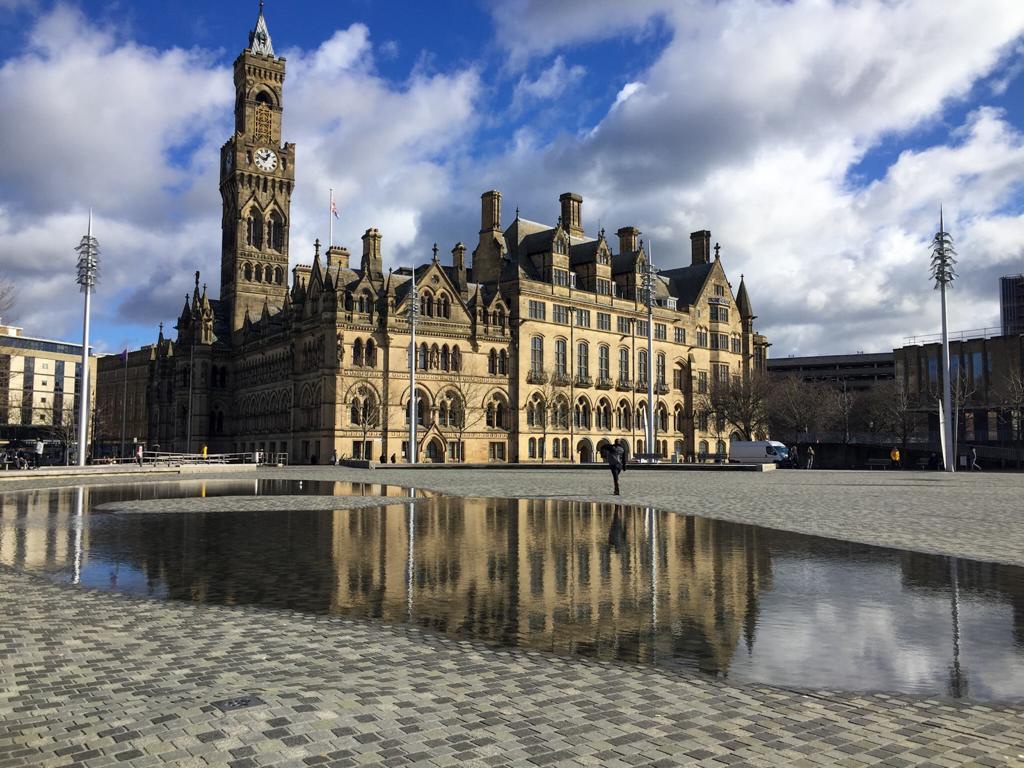The first sight of Bradford was of a lonely chimney billowing out white clouds into the atmosphere. Evidently smoke was pumped from the many chimneys that once “adorned” this market and industrial town. The single chimney was a poignant reminder of the past and of the changes that this city has undergone. My expectations for this city were very low. It wasn’t one of those cathedral cities that are so rich in history and beauty. It was a town for many years before that wealth of 100 years ago brought about expansion. Nowadays Bradford is associated with its diverse cultural population and industrial heritage.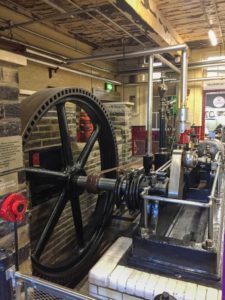
My arrival into the city did not endear me to the place – lorries, dodgy ring road (how do you know where the cars are coming from on these things?) An industrial heartland clearly devoid of any real beauty. Rumour has it that if you were to leave Bradford you would find some beauty on the Ilkley Moor or in Bronte Country. The drive in was atrocious as lorries vied to control the roads. Somehow, I managed to follow signs for the cathedral and escaped the mayhem of the dual carriage ways. I dumped the car which was relatively easily in the city centre in affordable car parking. A positive. The city is perhaps one of the country’s youngest. Up until 1733 it was merely a sleepy market town surrounded by trees. Oh, how those days are long gone! My first point of interest was the cathedral. One of England’s newest and smallest perhaps? It certainly wasn’t part of the blueprint that Henry VIII created all those centuries ago. In fact, this church didn’t become a cathedral until 1919 as a new diocese was created separate from that of Ripon, which in turn had been created due to the vast size of York’s diocese. There is no mention of Leeds here, so I wait with anticipation to see what that city delivers as Bradford clearly is more than a close neighbour. It is almost like two cities merged together.
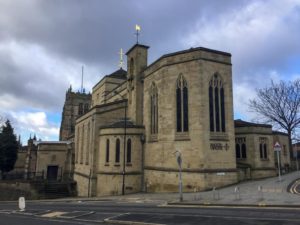
As mentioned, the cathedral is more like a large church. It is no way like the glamourous cathedrals that this country boasts. From the outside impressions this was not going to be one that would become a favourite of mine. Perhaps its beauty was to be found on the inside. I stepped inside with intrigue and was immediately impressed to see the welcoming sign declaring no entrance fee! Well done. My visit inside interrupted some form of gathering, so I rather silently and fleetingly made my way round the edges. The inside is not the work of art that others boast; this was clean and pristine and almost new. It still had some fascinating stained-glass windows. One in particular was of interest as at the bottom it looked like Fountains Abbey(?). My whistle stop tour was brief unlike other cathedral visits; this one had no real appeal. The outside on one side looked like it had experienced TLC, the other side a polar opposite. Weeds and overgrown grass covered an unloved graveyard.
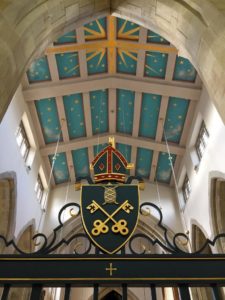
I left the cathedral in search of what might be the city’s charms. Would I find any, who knew? Its reputation didn’t promise many. But, isn’t that the fun of travelling and exploring? I immediately came across the main shopping complex, a modern monstrosity which somehow seemed like a clinically clean establishment in an otherwise dirty environment. I was immediately drawn to ‘to let’ signs in a window. Was this a sign of things to come or the ever-increasing confirmation that our high street is dying. You could say that the internet is the cancer that is destroying town life. Every now and then councils and governments give these towns a fresh hope of new life after a makeover, but slowly and surely their chances of survival decreases by the day. To get to the city centre I came around the Kala Sangam, an art centre. Lying in between the new mall and Kala Sangam a statue to the WE Forster (who he is – I don’t know; a search on the internet shows that he was an industrialist, philanthropist and generally good guy). In passing I read about another good guy (still with us) from further up country who is trying to revitalise a town, the name of which escapes me. In an interview he described the word philanthropist as a ‘vomit-inducing’ word. Very interesting coming from one who wishes to plough some of his wealth back into society. Back to Bradford. In glorious sunshine this statue gave a positive feel to the centre. A quick walk through the modern hustle and bustle and I was off to find the city park and town hall. It was here that you can begin to see where Bradford’s reputation lies. Buildings not in use, lost souls wandering the streets aimlessly, a prolific police presence. Now I was beginning to see where the city’s tarnished reputation came from. I felt like a foreigner as two distinct cultures are evident. I was amazed to pass a cycle shop that displayed a sign claiming that this was the city of cycling. A thousand bikes in Amsterdam or Beijing it was not. I can’t recall seeing anyone pedalling.
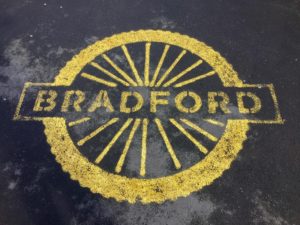
I won’t say this was my most treasured or favourite city walks, there was a fear that accompanied my every step. There was no clear heart and soul of the city. Instead a trail of mess, abandoned stores, homeless people and carefree individuals strolling about the place. Also throw in an evident mixture of cultures and it made for a diverse spectacle. I walked round, passed Bradford’s idea of the flatiron building from New York and made my way to the town hall which was something that you would associate with our friends across the pond than a city in England. This is clearly a focal point of the city centre. Next to it lies the modern enhancement of a Mirror pool. On arrival I thought it was a puddle left by the heavy rain, but it was put there on purpose. When the wind died down it did provide puddlegram opportunities of the highest order. A park in the city centre naturally attracts all that’s good and bad with a city, people happily mingle on lunch breaks on one side as rowdy and noisy kids boom out their modern rap music for all to hear. A pleasant and yet equally forgettable experience.
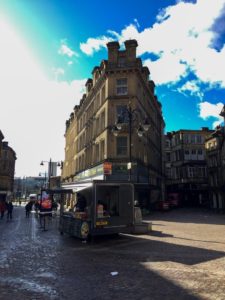
From here I made my way to the theatre Alhambra. Its appearance is more in line with that of a mosque than a west end theatre. It was perhaps surprising to see my favourite west end shows advertised on the outside – ‘The Lion King’. Directly next to it is the science and media museum. If more time was available this should be visited as it’s free to enter and has links to the city’s history of film and photography. Lying in between the two (the museum & the theatre) are the war memorials and a Victoria statue.
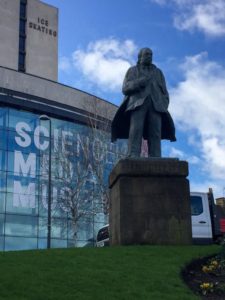
Bradford became wealthy in Victorian times. Perhaps they thought she was recognisable. The wool mills that made it a virtual capital of the world clearly brought wealth and prosperity. Sadly, this wealth looks a thing of the past. A visit to the industrial museum shows the power that once was associated with this place. Old machinery is now a thing of heritage keepsake as more modern advancements mean these machines are redundant. A visit to the museum shows the size of these enormous, “satanic mills” that were surely a death trap to most but, the sale of the products they made lined the pockets of a few. There are many information signs confirming the perils and dangers of working in such an environment. Children were sold to the mills in order to grow personal income. How times have changed! Health and safety, slavery, equality and working rights personnel, had they existed, would have had a field day. There were other exhibitions in the museum that provided insight to Bradford’s association with cars. It was a pleasurable to admire the quality of craftsmanship. My short visit gave me enough of an insight into the tough and hard upbringings that the people of the city must have endured.
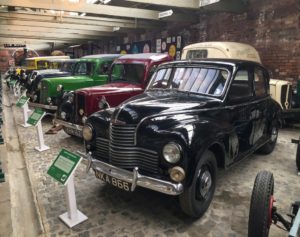
So, my voyage into the unknown has provided me with much food for thought. With expectations low, a reputation it clearly needs to shake up, the city provided many a good photo, but that shouldn’t muddle the mind. For this is a place that shouldn’t be visited alone and with your senses focussed. It has given me some sight into the industrial revolution some 200yrs ago, but as we now encounter a technological & social revolution, the similarities with a past industrial revolution might soon be there for all to see with the demise of the high street.
Bradford, England, United Kingdom

